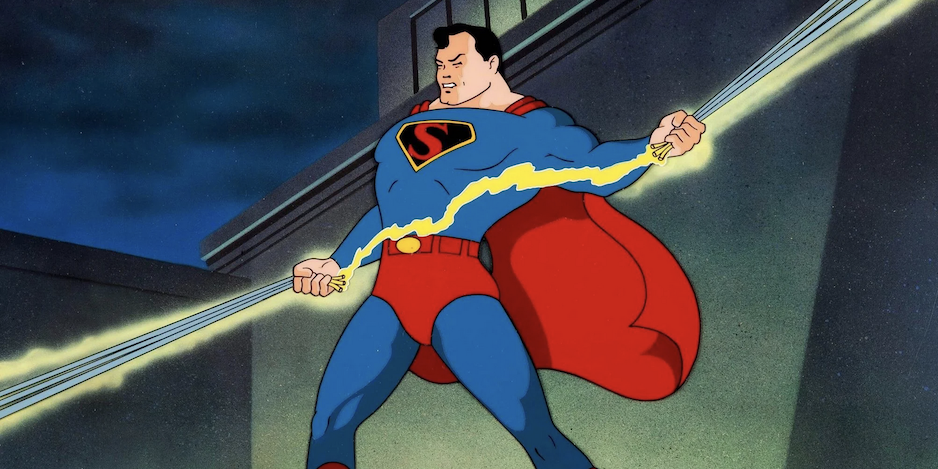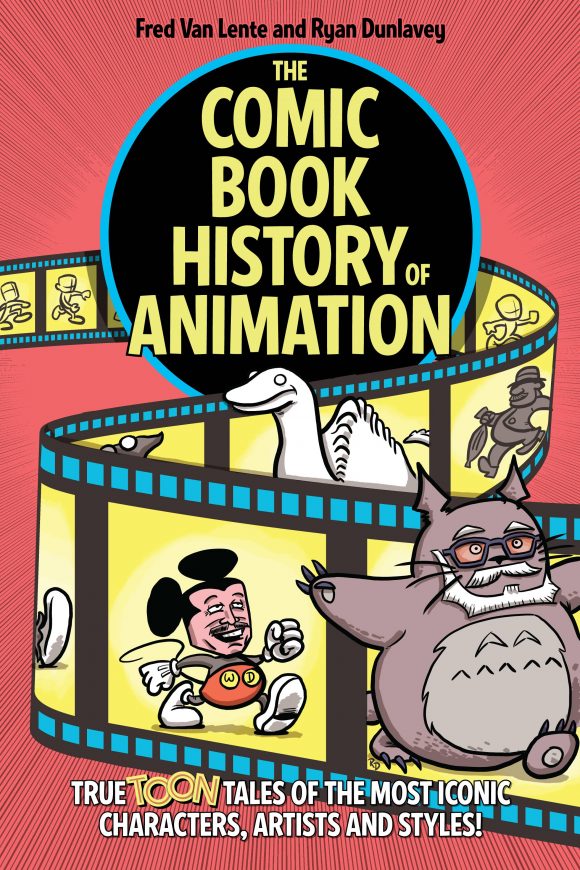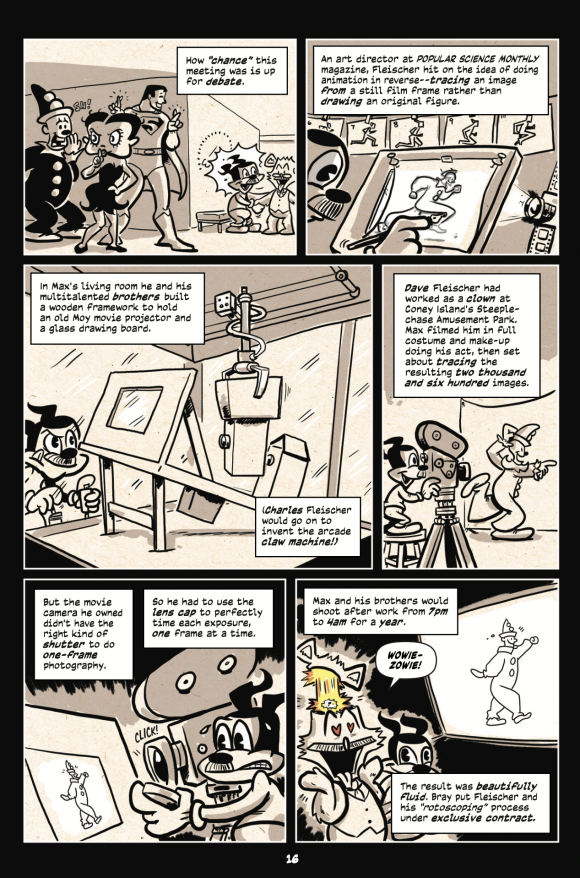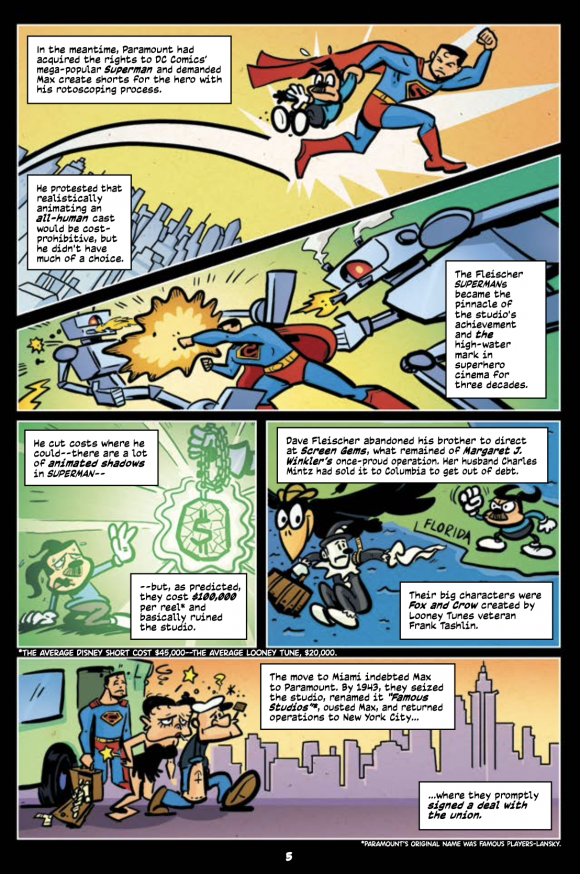The late, great Max Fleischer was born 142 years ago!
Who better to pick the TOP 13 Fleischer Superman cartoons than animation maven Fred Van Lente, our intrepid contributor?

—
UPDATED 7/19/25: The late, great Max Fleischer was born 142 years ago! Perfect time to reprint this 2021 piece! Dig it! — Dan
—
By FRED VAN LENTE
The pioneering animator and inventor Max Fleischer’s birthdate is July 19, 1883, and is it any coincidence that on July 20, 2021, the trade paperback of The Comic Book History of Animation – by artist Ryan Dunlavey and me — arrived on store shelves worldwide?

I mean, yes, it absolutely was a coincidence, Ryan and I are not smart enough to plan these things, but you hardly need an excuse to celebrate the achievements of Max Fleischer, a true pioneer in the field. In CBHOA, Ryan and I elaborate on his humble beginnings in the industry:

After working for cartoon studio mogul J.R. Bray, Max and his brothers opened their own studio in Times Square, where they produced classic series like “Out of the Inkwell,” “Betty Boop” and “Popeye the Sailor,” adapted Einstein’s Theory of Relativity into an animated short, and even invented the famous “Follow the Bouncing Ball.”
Unfortunately, labor troubles embittered Max against his own employees, and he moved his studio to more management-friendly Miami. Sadly, this was the beginning of the end for him. Even though he produced a well-received feature, Gulliver’s Travels, to compete with Walt Disney’s output, the studio’s remote (by 1940s standards) location caused constant cost overruns and personnel shortages.
But the worst was yet to come. As Ryan and I explain:

They may have caused huge challenges at the studio, but there’s a lot to love about the Fleischers’ Superman toons. With all due respect to Margot Kidder and Dana Delaney, they have my favorite depiction of Lois Lane, ever. The Fleischers’ Lois has the über-confidence of a cokehead on an all-night bender and the self-preservation skills of a toddler chasing a ball onto an eight-lane highway. How she survived this long before the guy from Smallville arrived is a complete mystery. For some reason she is the character with the fewest lines in her face, just daubs of color, so maybe she’s some kind of invincible pillow person?
The corporate shenanigans behind these cartoons were so FUBAR that they fell into public domain years ago. Various prints and edits have floated around on video forever; fortunately for Amazon Prime subscribers, the streamer has a shockingly deep bench of historically important animation, and you can watch all of the Superman shorts there — here’s the TOP 13 I think you should watch, in chronological order!
—
1. “Superman” (Dir. Dave Fleischer). The Daily Planet learns a nut with a death ray is threatening the city. What does Lois Lane do? Do some interviews on deep background? Infiltrate the bad guy’s lair in disguise? HELL no. That’s not how OG Baller Lois rolls. She flies a plane to the guy’s lab, lands at his front door, and starts bombarding him with questions. He of course promptly ties her up and plans to kill her. Once Superman saves her from the exploding lab, she returns to the Planet and scoops Clark Kent on the story. YOU GO, GIRL.
—
2. “The Mechanical Monsters” (Dir. Dave Fleischer). Max Fleischer was an incredibly accomplished inventor who held about a zillion patents, most importantly for the rotoscoping process used so liberally in this series. So all the tech in Superman looks great: These automated bank-robbing bots kind of look like they might actually work—when they’re not getting glitch-slapped by Supes, that is. Woman Without Fear Lois Lane stows away inside one of the mechs; while trying to rescue her, Superman is nearly electrocuted by power lines. Find better friends, Clark.
—
3. “Billion Dollar Limited” (Dir. Dave Fleischer). Cowled crooks attack a massive gold shipment with proto-punk nihilist Lois “No Future” Lane aboard. Basically a long chase scene between a sedan and a train, then between a train and Superman, it’s pretty rad. Lois, who I just want to make very clear, gives zero fucks, uses a tommy gun to hold off the robbers herself until a destroyed bridge requires Superman’s intervention.
—
4. “The Arctic Giant” (Dir. Dave Fleischer). Archeologists discover a frozen dinosaur in Siberia and bring it to display in Metropolis. The minute Lois Lane, Deathtrap Magnet, is assigned the story, you know that refrigeration unit is going to break and we’re going to have a good old-fashioned Godzilla Stomp on our hands. All the monsters and animals in the series look much cartoonier than the meticulously rotoscoped humans (i.e., traced from live-action film), which adds to the series’ charm.
—
5. “The Bulleteers” (Dir. Dave Fleischer). Flying bullet cars threaten to destroy Metropolis unless they get the contents of the municipal treasury. These guys may know their way around bullet cars, but they don’t know jack about American cities’ finances. I live in and occasionally work for New York City, and I am pretty sure the entire contents of our treasury are three pizza rats and a “Lindsay ’72” bumper sticker.
—
6. “The Magnetic Telescope” (Dir. Dave Fleischer). A guy sticks a giant horseshoe magnet on top of an observatory, and everyone acts surprised when it draws murderous comets to Metropolis. Weirdly, Superman decides to take a cab to the observatory to rescue Lois, voted Most Likely to Be “Deep Impacted” in high school. A comet bit causes his cabbie to flee, inspiring the Man of Steel to change means of transportation and fight back the unwelcome celestial visitor himself.
—
7. “Electric Earthquake” (Dir. Dave Fleischer). This one is so daffy it may be my favorite of the bunch. A Native American mad scientist emerges from his undersea lab and threatens the Daily Planet with manmade earthquakes that will destroy the city if his tribe doesn’t get its $24 refund for selling them the land in the first place. Why he delivers this threat to the Planet and not, say, to the Department of the Interior is anyone’s guess. At least this gives Lois Lane, Human Carry-On Item, a chance to hide aboard the bad guy’s pneumatic sub.
—
8. “Volcano” (Dir. Dave Fleischer). Mt. Monokoa in the Pacific has been upgraded from dormant to active volcano, giving Lois an excuse to get killed in some other time zone. Unfortunately, Perry White makes her take spineless milksop Clark Kent with her. Ugh! Lois swipes Clark’s press pass to leave him behind so she can travel directly to the mouth of the volcano, which of course erupts within five seconds of her arrival. She almost manages to scale down a cable car line by herself before Superman rescues her. This is our own Dan Greenfield’s favorite of the series, and it’s not hard to see why: Its apocalyptic images are pretty terrific.
—
9. “Terror on the Midway” (Dir. Dave Fleischer). The circus is in town, providing Lois Lane with many new and colorful options for self-destruction. Someone lets the giant gorilla loose, and Superman disappoints her once more by saving her. Not exactly the most original tale, but the gorgeous deep-focus animation (I’m guessing via yet another Fleischer invention, the setback camera) looks dynamite.
—
At this point in Superman, the Paramount takeover happened. Other than Fleischer Studios becoming “Famous Studios” in the credits, I can’t say there’s a hugely noticeable difference, although the series does become a lot more dependent on racial and/or ethnic stereotypes of varying levels of awfulness. (Particularly in comparison to the respectful treatment of the Native American villain in the Fleischer-produced “Electric Earthquake.”) Though Golden Age comics were hardly paragons of progressivism, they were positively Woke compared to Golden Age cartoons, which were full of offensive caricatures and racist humor. African-Americans were the primary butts of jokes before World War II, but directly after Pearl Harbor the Japanese (and Asians in general) got the worst of it.
That said, many of the Famous Studios entries do continue the high quality of the series:
10. “Showdown” (Dir. I. Sparber). I’m fond of this one because it is one of the few that appears to be lifted directly from the comics, an early Siegel and Shuster effort about a crook who dresses in a Superman costume. Why the mob doesn’t realize this is going to attract the attention of the real Superman I have no idea, but I guess Metropolis isn’t sending its best and brightest to the Mafia. The crooks flee and Superman gives pursuit through and outside the boss’ cliffside mansion in a terrifically animated chase sequence.
—
11. “Eleventh Hour” (Dir. Dan Gordon). Compared to the pure Cringe of Warner Bros’ “Tokyo Jokio” and “Bugs Bunny Nips the Nips,” the two World War II anti-Japan Superman entries are relatively mild… though the title of one, “Japoteurs,” should give you some idea of what to expect from this kind of propaganda.
Though DC famously refused to let the Man of Steel get too involved in World War II, Paramount shows no such compunctions. Clark and Lois are in a Japanese port on assignment, giving Superman the opportunity for some nocturnal maritime sabotage. Not being complete idiots, imperial authorities arrest Lois and threaten to execute her if Supes doesn’t knock it off. Clark accidentally buries himself in a dry dock truss, delaying her rescue until the last second, as implied by the title. It’s a pretty thrilling and suspenseful cartoon, but consider yourself trigger-warned against the stereotyped depiction of a wartime foe.
—
12. “The Mummy Strikes” (Dir. I. Sparber). Again, a short that harks back to the earliest of Superman strips—Superman works to free a woman unjustly convicted of murder. She’s been accused of poisoning her boss, a hieroglyphics expert who may have actually been cursed by King Tush (snicker) in the Egyptian wing of the museum. While investigating, Clark accidentally frees two giant, conspicuously unwrapped Nubian mummies.
—
13. “The Underground World” (Dir. Seymour Kneitel). Lois and Clark join a scientific expedition into a vast cave system, which, of course, leads to a vast undiscovered civilization of virile, R. Crumb-esque bird people. Why bird people would choose to live under a mountain instead of, I dunno, on top of it, where they could like, spread their wings and stuff, goes undiscovered as Superman buries them in a rockslide to prevent them from dipping Lois in molten gold. The use of color and shade in this cartoon is especially striking.
—
MORE by FRED VAN LENTE
— The TOP 13 JOE SHUSTER SUPERMAN Stories — RANKED. Click here.
— The TOP 13 SPACE GHOST Villains — RANKED. Click here.

July 19, 2021
Love the hilarious focus on Lois Lane in this list. I am just as much a fan of Lois as I am of Supes himself. “YOU GO, GIRL,” indeed.
July 19, 2021
I liked “the mummy strikes” except at the end when Lois imitates black Stereotype talk at the end of the cartoon that made me cringe.
July 19, 2025
You can uncringe; Lois isn’t doing dialect, she’s quoting “Blues in The Night”, a popular song of the era.
July 19, 2021
Happy birthday to the late Max Fleischer. I’m grateful to him and his team for inventing Superman’s ability to fly. 🙂
July 19, 2021
“Japoteurs” is one of my favorites because a)I love the idea of an aircraft carrier in plane form b)the effort it takes Superman to stop said plane carrier from crashing in Metropolis’ version of Times Square!
July 25, 2021
THE JAPOTEURS was the first Superman cartoon to come from Famous Studios. Interestingly it is not on this list. But for a tribute to Max Fleischer and Fleischer Studios, why are the Famous Studios cartoons listed? He and Dave had nothing to do with them by that point since they were both out at the beginning of 1942.
July 19, 2021
Love the hilarious attention to Lois Lane in this list. I am just as much a fan of Lois as of Supes himself. “YOU GO, GIRL,” indeed.
July 19, 2021
Interesting factoid. In electric earthquake, the city is not referred to as metropolis, but Manhattan island..
July 19, 2021
Real soft spot for Showdown. The opera house, the lighting. The Edward G Robinson hood. It’s all so good.
July 19, 2024
One of my favorite moments in the series is the scene where he just stands there, waiting for the Boss to realize who he is.
July 22, 2021
Not a Superman cartoon, but Fleischer related is “Shesick Sailors”, a Popeye cartoon with Bluto imitating Supes. My favorite of all the Popeye cartoons.
July 23, 2021
I have always ADORED the Lois Lane of the Fleischer toons.
And have always thought that Rosalind Russell in “His Girl Friday” was a huge influence. Am I right, Dan?
Speaking of, was Phyllis Coates==the original Lois in THE ADVENTURES OF SUPERMAN–also influenced by Russell and the Fleischer toons?
For me, Coates’ depiction was ACES!, miles above that of Noel Neill’s. (To be perfectly honest, I absolutely hated the latter’s Lois.)
P.S.: Both Fleisher and Coates were big influences on me in my LOIS LANE mini-series.
July 25, 2021
The original personality of Lois Lane came from Joan Alexander’s performance on the radio program. For the most part, the radio cast of Bud Colyer, Joan Alexander– and Jackson Beck as Perry White in the first entry, was used for the cartoons, although I believe that someone may have substituted for Bud Colyer a couple of times.
July 25, 2021
The reason why Noel Neill replace Phyllis Coats is because the TV series did not go on the air right away, and when it was renewed for a second season, Phyllis was under contract to another series and unavailable. And since Noel had played Lois Lane in the two Columbia series from 1948 and 1950, she was asked to return. So like it or not, THAT’S what happened and why.
July 25, 2021
I’m sure Rosalind Russell was a Lois Lane inspiration over the years. “His Girl Friday” came out in 1940, so the Fleischers could definitely have been influenced. I’m not 100 percent sure but it makes a lot of sense. I agree too that Coates doesn’t get the credit she deserves and was likely influenced by Russell, as well.
July 25, 2021
DESTRUCTION, INC. and SECRET AGENT, the last in the series is also missing from this list.
July 25, 2021
While this is an interesting approach, the “interpretation” shows signs of passages from my book (and others) with facts being lost in the translation. First of all, Max Fleischer was the Art Editor at POPULAR SCIENCE MAGAZINE, which is stated quite clearly in the book. It was his boss, not “an Art Director” who suggested the idea that became the Rotoscope. Also the cost of the SUPERMAN cartoons WAS NOT $100,000 each, as Dave Fleischer claimed in 1968. Their 1941 contract lists what the allocated funds were, and they were nowhere at this figure. Allowing for the entire series of 12 cartoons came to a total of $435,000. Divide that by 12 and you get the average cost, $36k. Paramount would never have allocated $100k per cartoon. Not even Disney was spending that much money then. This is something to consider when Paramount barely gave Fleischer enough to producer their most lucrative series, POPEYE. And the SUPERMAN cartoons did NOT ruin the studio. It was other reasons, as detailed in the book. Logic would tell you that if SUPERMAN were such a “liability,” Paramount would not have continued the series for another two years. But they did. I can tell you had fun doing this. But this can be done by following the facts that many others, including myself have established though our decades of work so that you and others can know the stories behind this fascinating subject.
July 25, 2021
OK
July 20, 2024
>> passages from my book……
What book is that? I’d be curious to read up more on the creation of these animated shorts. Case in point, do you know what’s up with the colors of Superman’s shield being so off? Was it just a “no one thought anyone would notice or care” or, did it have something to do with production restrictions or cost?
July 19, 2025
Time to answer my own question. I think this must be the book that Ray is referencing. The Art and Inventions of Max Fleischer: American Animation Pioneer https://a.co/d/598Uke7
July 22, 2025
I have your book and liked it. Leslie Cabarga’s book says they asked for $90,000 an ep never thinking they’d get it, and they got it.
July 19, 2025
It should be noted that “The Mechanical Monsters” included both the first-ever appearance of the classic phone-booth costume change (years before it occurred in the comics) and the series’ only use of X-Ray vision (with a rather striking visual effect.)
July 19, 2025
When we lived in the Rio Grande Valley in the 1970’s, the ‘Border Blasters’, TV stations located in Mexico would play old B&W movies, serials and, of course, the Fleischer Superman cartoons. They really captured my imagination.